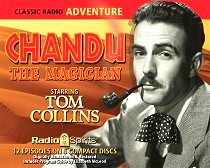
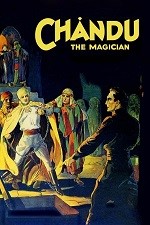 Chandu the Magician (1932-35, 1948-50) aired “The Wizard of Kalahari” on December 10, 1949 as the renumbered 4th of the 6 half-hour episodes that picked up in November to finish 1949 after its hiatus in May of that year.
Chandu the Magician (1932-35, 1948-50) aired “The Wizard of Kalahari” on December 10, 1949 as the renumbered 4th of the 6 half-hour episodes that picked up in November to finish 1949 after its hiatus in May of that year.
The first run (1932-35) consisted of daily 15-minute episodes that became popular very quickly, so much so that a 1932 film soon followed the radio adventures of Chandu. The idea behind Chandu the Magician stemmed from the public’s interest at the time with Eastern mysticism and the occult. The Chandu character’s fictional real life name is Frank Chandler. Chandler has spent many years in the Orient studying the mystic arts and is now adept at astral projection, conjuring illusions, and teleportation among other magical abilities he uses when necessary. If this sounds like a familiar set of superpowers it was, witness magazine and radio close contemporaries like the Shadow or Mandrake the Magician—though Chandu on radio was the first. The original story arc sees Chandu chasing after the evil Roxor, who has kidnapped the husband of Chandu’s sister, Dorothy Regent. Chandu and his sister travel to all sorts of exotic locales in search of her husband (who was thought to have disappeared in a shipwreck but later to have disappeared at the hands of Roxor). Roxor, as all truly evil villains are, is bent on conquering the 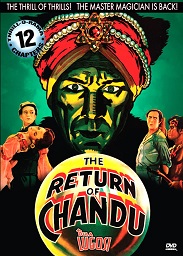 world and will stop at nothing to accomplish his egomaniacal ends. For the original 1932 movie, actor Edmund Lowe played Chandu, while none other than Bela Lugosi took the role of Roxor. For the 1934 sequel, however, in a surprising role reversal Lugosi was honored with the role of Chandu.
world and will stop at nothing to accomplish his egomaniacal ends. For the original 1932 movie, actor Edmund Lowe played Chandu, while none other than Bela Lugosi took the role of Roxor. For the 1934 sequel, however, in a surprising role reversal Lugosi was honored with the role of Chandu.
A crucial bit of the history of the show would be incomplete without mentioning that a great part of the radio show’s success was due to a young woman by the name of Vera Oldham, a former office girl who proved good on her aspirations to write. After the radio series ended in 1935 and the Chandu films were long over, Chandu was resurrected on radio in 1948, with the former story arc refurbished and updated (even bringing back Oldham to touch up the scripts), continuing Chandu’s travels to mysterious and little known parts of the world (the fabled land of Lemuria for one), and gifting him with a love interest of surpassing beauty in the character of the Egyptian princess Nadji.
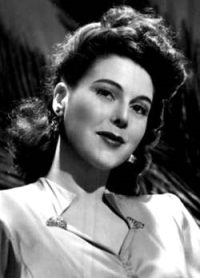 For the 1948-50 radio revival, the episodes from June of 1948 through the end of January 1949 were daily 15-minute episodes, then from February of 1949 through the final show on September 6, 1950 Chandu would become full half hour, self-contained stories, of which this week’s episode is one. Tom Collins (1913-73, photo top right) would become the new voice of Chandu, Irene Tedrow played his sister Dorothy, and the talented film actress Veola Vonn (1918-1995, photo at left) was Princess Nadji. In this episode, however, neither Chandu’s sister nor Princess Nadji appear.
For the 1948-50 radio revival, the episodes from June of 1948 through the end of January 1949 were daily 15-minute episodes, then from February of 1949 through the final show on September 6, 1950 Chandu would become full half hour, self-contained stories, of which this week’s episode is one. Tom Collins (1913-73, photo top right) would become the new voice of Chandu, Irene Tedrow played his sister Dorothy, and the talented film actress Veola Vonn (1918-1995, photo at left) was Princess Nadji. In this episode, however, neither Chandu’s sister nor Princess Nadji appear.
“The Wizard of Kalahari” finds Chandu in Nairobi, the capital city of the east African country of Kenya. He has been called in to find and stop the titular wizard of Kalahari who has been murdering and otherwise scaring the local native work force. Chandu learns that in this specific time period Nairobi is on the verge of great commercial expansion, with dams along the Nile on the drawing board to harness its potential electric power, land for great plantations to produce food for the city’s inhabitants needing to be set aside for planting and harvesting, and various other essential services. But there are those being well paid to thwart or permanently cancel such growth initiatives, the primary culprit being the invisible but greatly feared wizard of Kalahari, whose faithful minions obey his every command. After surviving an assassination attempt, Chandu puts all of his knowledge and powers to the task of finding this wizard, whose magic does indeed appear potent and deadly. What Chandu discovers is quite a shock when one magician meets face to face with a fellow magician, and leads to a most unexpected resolution. So get ready—as the introduction teases—for a story of magic and mystery, as Chandu must defeat the magician no white man can see, “The Wizard of Kalahari.”
Play Time: 29:21
{This episode of Chandu the Magician aired on a Saturday evening in early December of 1949. This meant that the next day after church a visit to the nearby newsstand was in order for the neighborhood gang, just to be sure they hadn’t missed anything from their previous visit a scarce two days before. It wouldn’t do to run out of reading material before the weekend was over, with the cold weather meaning they might find themselves spending more time indoors the rest of the day than they would have liked. Adventure (1910-1971) was begun when it saw that Argosy had a circulation in the hundreds of thousands per issue and wanted to cash in on its audience. But where Argosy had a broader range of material (from romance to danger as one source had it), Adventure specialized in danger and thrills. It was a monthly in 1949. Argosy (1882-1978) was one of the oldest pulps and weathered several format and material changes over its long life. It saw its last pulp format issue in August of 1943, evolving into a slick format from then on. It too was a monthly in 1949. Since the gang had bought all of their usual pulps for the month, one of them went for this innocent looking Christmas issue of Argosy drawn to it by the puppy with the large, endearing eyes daring anyone to pass it by. With all the talk of gender issues today–especially the transgender issue in the news recently–I found the second article (or story) listed on this cover to be ironically relevant (though I’m sure it held a different connotation in 1949). The article title reads as “The Woman Who Became a Man.” And from Argosy, no less. Who knew? Blue Book (1905-56) began primarily as a women’s magazine and was quite successful with its formula. Over time, however, it broadened its scope to accommodate new generations of readers and would see fiction by such as H. Rider Haggard, Agatha Christie, and the most popular of them all Edgar Rice Burroughs with new Tarzan stories. Harold Lamb, another name familiar to early fantasy and adventure fans, was spotted on the cover by one of the gang, thus ensuring an instant sale. Blue Book was also a monthly in 1949.}
[Left: Adventure, Dec. 1949 – Center: Argosy, Dec. 1949 – Right: Blue Book, Dec. 1949]
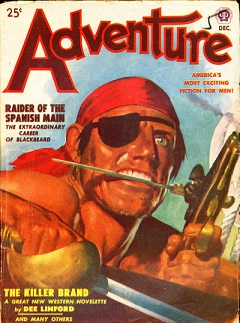
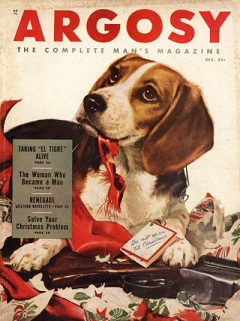
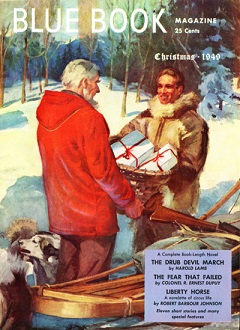
To view the entire list of weekly Old Time Radio episodes at Tangent Online, click here.